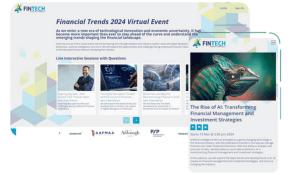Global corporations are moving their world-renowned conferences onto the digital spectrum. Stalwarts of the event industry, like Eventbrite, are reporting a 90% drop in revenue.
COVID-19 has changed the events landscape. Virtual events have stepped into the limelight, and they’re changing the game.
But, are virtual events a suitable replacement for their in-person equivalents?
It’s evident that the coronavirus pandemic has changed what normal looks like for us all, and the events industry is no different. In-person events from music and art festivals to international conferences have been cancelled, and revenue is dropping.
Trade shows, conferences, and events are the bedrock of corporate branding, networking, and sales. And hopefully, that won’t change overnight.
In the place of physical events and conferences, we see companies like Google and Microsoft turn to a “new virtual format”. This is pretty good news for companies like WorkCast, but are these virtual events effective?
Are virtual events effective?
Yes, they are. We’ve written about in detail in our virtual events vs. in-person events head-to-head.
We’re lucky to have the inside scoop at WorkCast, and what we’ve found is interesting:
- The total number of events run on the WorkCast platform from April to June 2020 was 200% higher than the previous period from January to March.
- We saw a 400% increase in overall event attendees from April to June this year (compared to the previous period).
- The average registrant to conversion rate during the pandemic has consistently been over 60% across all events.*
*In comparison to an industry-standard of around 40%.
A 20% increase in the average conversion rate is a good thing. Virtual events are clearly very effective, if not more effective, than their in-person counterparts.
As Jennifer Kingen Kush, from Kingen Kush Solutions, says, “[to] hold a face-to-face event might require a lot of money to invest upfront. But you could beta-test it with a digital experience and attract a new audience.”
Virtual events platforms
The industry has transformed, and we’re just starting to work out what it means. If current trends continue, then virtual events could be the predominant mode of content consumption, networking, and conducting business.
As that change happens, we’ll see (and we are seeing) tech companies of all sizes looking out for a slice of the pie.
As Stewart Kibby, WorkCast CEO, says, “online events are more scalable, cost-effective, and more accessible than their physical counterparts. As more and more organizations make this shift, the services and technology will only continue to improve.”
It’s up to companies like WorkCast to continually develop our Stratus platform. Integrating new functionality and improving the range of services that we offer is crucial to staying ahead of the curve.
A problem with virtual events
It’s clear that virtual events are the “new normal” for brands and businesses across the globe, but there are some key differences that companies need to remember.
As John Koetsier notes, “the challenge with a virtual conference is that you don’t have a captive audience. Everything from regular work — and family life, now that you’re working at home — is still happening. Emails still ding. Phone calls still happen. Slack still fills up with messages.”
Victoria Copans from eventmanagerblog.com states that “40% of planners have been unable to organize a successful virtual event this year.” The problem, she says, is engagement.
“Figuring out how to engage a remote audience is incredibly challenging and requires a different set of knowledge and skills than what most planners who are accustomed to live events may have been cultivating.”
So, there’s no shortage of virtual event platforms, but how do you keep your event engaging online?
How to make virtual events more engaging?
Content. We know it’s easy to say that “content is king,” but it really is. Here are a few simple ways you can enrich your virtual event content and increase audience engagement:
- Excite and energize at the start - motivate your audience from the beginning, and they should stick around.
- Perfect your content - use a graphic designer, rehearse your presentations.
- Limit session length - cut the cr*p and retain your audience’s attention.
- Make it interactive - Are you using polls? Are you pulling in widgets like Slido? Are you utilizing video? Ever tried the ‘empty chair’ panel?
- Make networking simple - remote attendees need to talk to each other. Provide that opportunity for them.
Check out our Ultimate Webinar Checklist to make sure you nail the most important element of any virtual event - the session itself.
So, is the “new normal” a better normal?
We’ve seen an enormous shift in the virtual event landscape at WorkCast since the onset of COVID-19, and it looks like it’s here to stay.
Stewart Kibby, WorkCast’s CEO, says, “we’re witnessing a dramatic shift in the way people consume content. As businesses move their events from in-person to online, they are experiencing the immense benefits of the virtual environment”.
The industry has transformed, and we’re just starting to work out what it means. If current trends continue, then virtual events could be the predominant mode of content consumption, networking, and conducting business.
If virtual events continue to perform as well as they are, then the “new normal” could mean wider reach, more opportunity, and better profitability for brands and businesses worldwide. Just keep audiences engaged.
Learn more about WorkCast's Virtual Event platform.
Learn How To Create A Virtual Event On A Budget in our free webinar.
Share this
You May Also Like
These Related Stories

Mini VE: Keeping Virtual Events Simple!
Virtual Events Vs. In-Person Events: Why to Host Online



